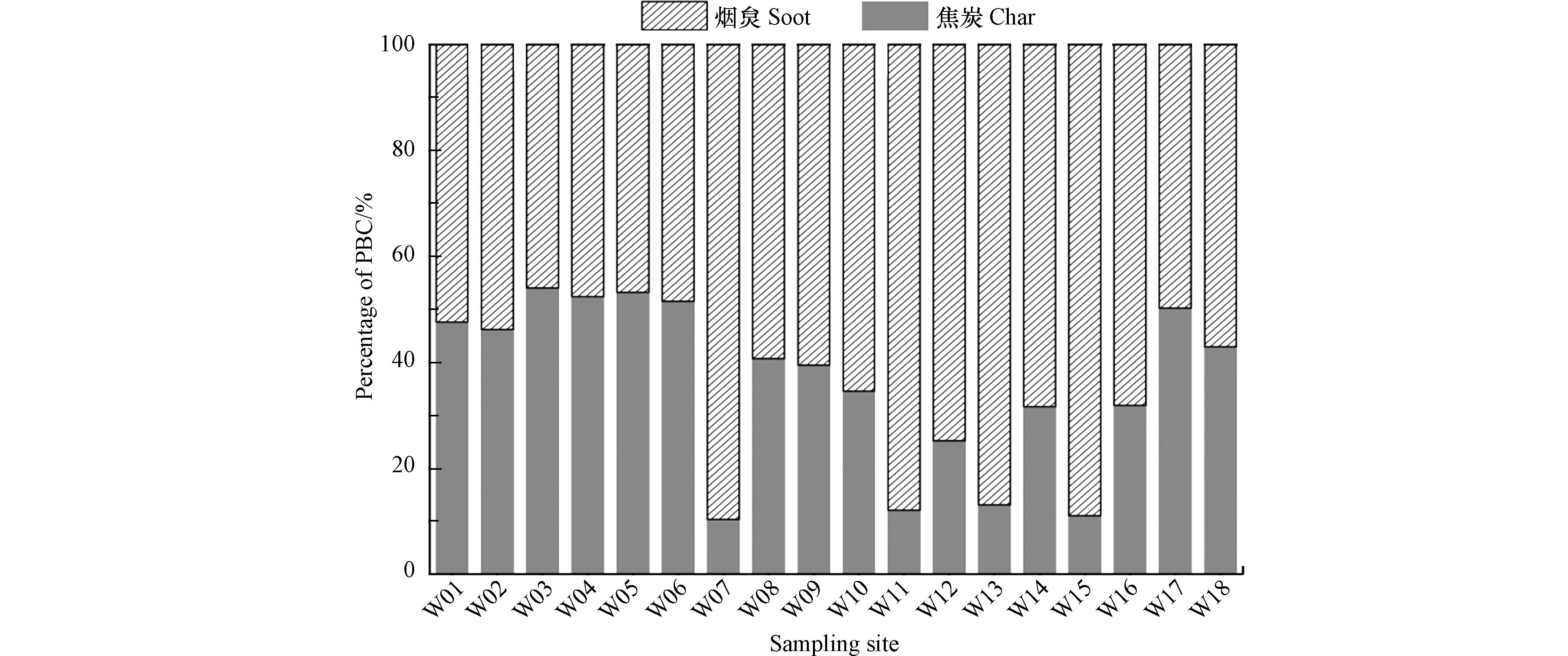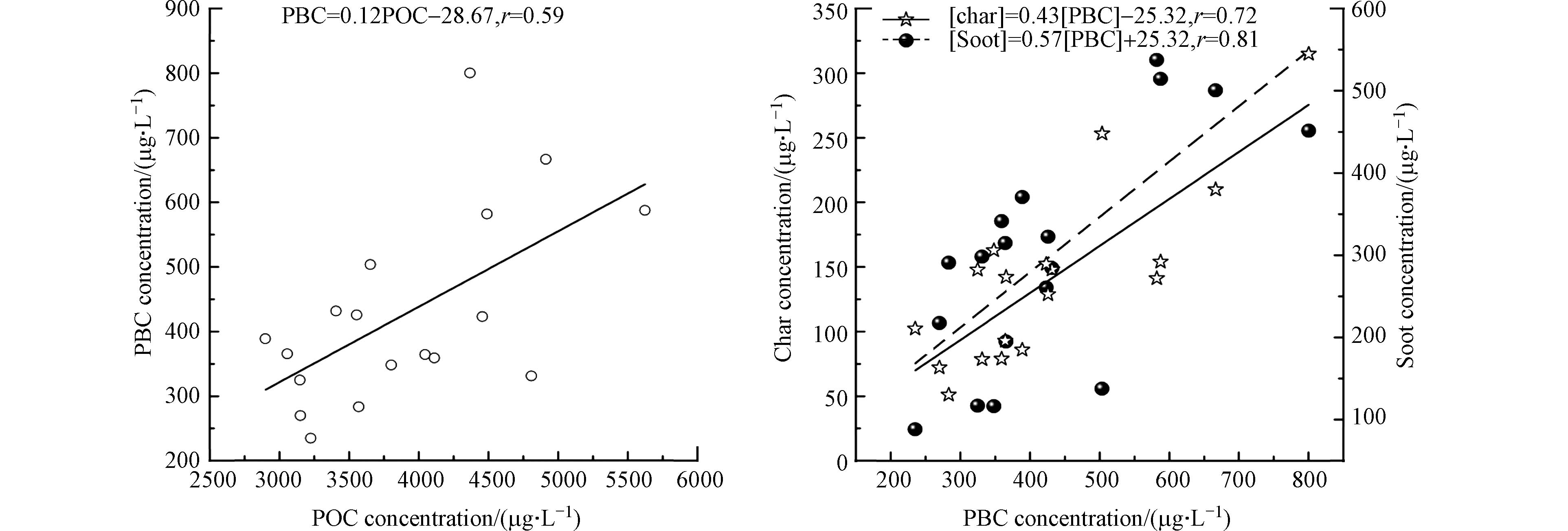-
黑碳(Black carbon,BC)是化石燃料和生物质不完全燃烧产生的一种非纯净碳的混合物,广泛存在于大气、土壤、水体(河流、湖泊、海洋)、冰雪等地球环境系统中[1 − 2]. 由于其特殊的物理化学特性,BC在全球气候变化、碳的生物地球化学循环、空气质量和公众健康等诸多方面都扮演着重要的角色[3 − 4],已成为当前国内外气候、环境和健康等研究领域共同关注的焦点[3,5 − 6]. 随着全球能源消耗的不断增加,BC排放量逐年递增,据估算,全球每年化石燃料燃烧排放BC 0.05—0.27 Gt (1 Gt = 1 × 1015 g)[7],生物质燃烧排放BC0.012—0.024 Gt[8]. 燃烧过程中排放的BC颗粒大部分进入土壤,还有一部分经过风力搬运、干湿沉降、地表径流等一系列作用,最终在河流、湖泊、海洋等环境中沉积下来[9 − 10].
湖泊作为具有独特生态、人文价值的地理单元,因碳循环强度高、碳排放总量大,被认为是传统意义上的碳源之一[11 − 12]. 湖泊碳循环不仅影响着全球碳循环,而且是全球气候变化与可持续发展的重要课题[11,13 − 14]. 湖泊中有机碳的主要存在形式为颗粒有机碳(particulate organic carbon,POC)和溶解有机碳(dissolved organic carbon,DOC)[15],而颗粒态黑碳(particulate black carbon,PBC)和溶解态黑碳(dissolved black carbon,DBC)是POC和DOC的重要组成部分[5,16]. 由于BC的化学稳定性,水体中DBC的含量一般相对较低[17 − 18],但是PBC在POC中所占比重则较高. 研究结果表明,太湖水体PBC在POC中所占比重最高可达30.88%[12];长江和黄河水体中PBC/POC约为13%±0.4%和22%±11%[19];在全球18条河流中,PBC/POC约为15.8%±0.9%[20];渤海和黄海PBC/POC约为19.1%±7.0%[21]. 由此可见,陆地水体中PBC的变化对调节POC库十分重要. 河流、湖泊和海洋等陆地水体中PBC的定量及来源研究对于探索BC迁移转化的驱动因素及其对碳循环的影响十分重要. 然而,目前关于湖泊水体PBC的研究报道还十分少见.
鄂东南地区矿产资源丰富,是长江中游著名的“冶金工业走廊”. 该区域工业历史悠久,能源消耗及交通运输排放的大量污染物通过干湿沉降和地表径流进入城市湖泊水体,导致湖泊污染尤为严重. 本研究以鄂东南典型工业城市湖泊——磁湖为研究对象,研究水体中PBC和POC的含量水平及空间分布特征,分析了PBC和POC之间的关系,同时结合黑碳组分特征比值法判断黑碳的可能来源,为研究鄂东南地区湖泊生态系统黑碳碳循环及黑碳对湖泊水环境的潜在影响提供科学依据.
-
磁湖(114°57′E–115°06′E,30°10′N–30°15′N)位于长江中游下段南岸,水域面积10 km2,汇水面积62.8 km2,总长38.5 km,平均水深约1.75 m,湖体容量1.75×107 m3,是湖北省黄石市市区最大的自然水体. 以杭州东路为界,磁湖被分为南、北两个半湖,担负着黄石地区水利调节和生态循环的重要作用. 考虑到湖泊水体的水动力条件等,分别在磁湖南湖和北湖共设置18个点位采集水样,采样点分布如图1所示. 2022年11月,根据《水质 采样技术指导》(HJ 494—2009)中的相关操作要求,用不锈钢取水器采集表层水样(距水面约0.5 m),装入用湖水润洗过的500 mL聚乙烯塑料瓶中,带回实验室后于冰箱中−20 ℃冷冻保存. 采样时采用手持GPS对各个采样点的地理坐标进行详细记录.
-
水体样品从冰箱中取出待冰融化后,加入一定体积1 mol·L−1盐酸去除碳酸盐,然后将水样通过直径为47 mm的石英纤维滤膜(Whatman,孔径0.7 μm)进行过滤,多次用蒸馏水洗涤酸化处理后的滤膜以调节pH值,然后将带有悬浮颗粒物的滤膜在60 ℃干燥6 h以便后续碳分析.
使用多波段有机碳元素碳分析仪(DRI 2015,美国沙漠研究所)测定样品中的黑碳含量,升温协议采用IMPROVE-A(Interagency Monitoring of Protected Visual Environments)[22]. 从样品滤膜上截取0.503 cm2的圆形滤膜至于碳分析仪中,滤膜在纯氦条件下阶段性升温,分别在140 ℃、280 ℃、480 ℃、580 ℃释放不同组分的OC(OC1、OC2、OC3和OC4),然后在2%氧气和98%氦气的混合气体中,在580 ℃、740 ℃、840 ℃阶段升温,释放不同组分的BC(BC1、BC2和BC3). 由于在阶段性氧化过程中,有一部分OC会因缓慢氧化转化为BC,这部分称之为裂解碳(OPC)[23]. 最终将POC定义为所有OC和BC组分的总和,即POC=OC1+OC2+OC3+OC4+BC1+BC2+BC3,将BC定义为BC组分的总和减去OPC,即BC=BC1+BC2+BC3-OPC[21]. 同时定义BC的另外两种形态,焦炭(char)=BC1-OPC,烟炱(soot)=BC2+BC3[23 − 24].
-
采用Excel 2019办公软件进行数据处理,使用Origin 2019和ArcGIS 10.2进行制图操作.
-
磁湖水体中PBC、POC、char和soot含量的统计结果见表1. 磁湖水体中POC含量在2899.38—5622.80 μg·L−1之间变化,平均值为3903.84 μg·L−1,中位数为3727.26 μg·L−1,变异系数为19.25%,属于中等强度变异. 磁湖水体POC含量比渤海和黄海POC含量明显要高[25],但低于西江流域POC含量[26],这可能与湖泊、江河和海洋水文特征之间的差异有着密切关系. 同时,由于不同采样点受到人类活动的扰动影响程度不同,湖泊水体中POC含量也存在着一定差异.
磁湖水体PBC、char和soot含量变化范围分别为235.01—800.08、24.41—310.23 μg·L−1和130.09—544.72 μg·L−1,中位数分别为377.25、155.52、272.65 μg·L−1,变异系数分别为34.72%、56.34%和38.98%,都属于中等强度变异. 这说明PBC、char和soot都可能受到人为活动的干扰. 分析原因可能跟不同采样点附近黑碳排放源的复杂程度有关,如道路机动车流量、机动车燃油类型及其他工业排放等人为活动的影响差异有关. 与国内其他湖泊、江河和海洋水体中PBC含量相比较,磁湖水体中PBC平均含量与太湖西北部PBC含量相近(450 μg·L−1)[12],但明显低于西江流域(1780 μg·L−1)[26],高于沿渤海海湾(32.2±24.3 μg·L−1)[27]和渤海及黄海北部(39.1 μg·L−1)[25].
磁湖水体中PBC/POC变化范围在6.89%—18.32%之间,平均值为10.92%,变异系数为26.63%(表1). 与其他研究相比(表2),磁湖水体中PBC/POC平均值略低于长江(13.0% ± 0.9%)与黄河(21.8% ± 11.1%)[28],但与太湖水体PBC/POC比值(11.62% ± 6.15%)相当[24]. 前人的有关研究指出大气、土壤与湖泊沉积物中的BC/TOC比值从一定程度上反映了不同环境介质中TOC的组成,大气、土壤和湖泊沉积物中BC/TOC比值分别为2.0%—69.2%、5%—60%和5%—30%[29 − 31]. 说明磁湖水体中PBC对POC含量积累有一定的重要作用,也间接地说明城市湖泊水体中PBC可能影响水体POC的碳循环. 磁湖水体中soot是PBC的主要组成部分,其变化范围为45.92%—89.61%,平均值为63.95%(图2). 这与前人的研究不一样,Huang等[12]发现太湖水体PBC的主要组成是char(平均值为55.33%).
有关研究表明,大气沉降是海洋表层水体中PBC的主要来源之一[32]. 磁湖水体焦炭/烟炱(char/soot)比值变化范围为0.12—1.18,略低于黄石地区大气降尘中char/soot比值(0.28—1.97)[33],说明大气沉降对磁湖水体中PBC的含量也有一定的影响,且磁湖水体中PBC与大气降尘中黑碳的来源相似. Huang等[12]对太湖的研究也发现了相似的结论. 磁湖水体悬浮颗粒物中char/soot比值远低于河流、海洋等沉积物(海州湾河流:2.75;黄海:3.42;东海:2.97;渤海:4.94)[34 − 35],这可能是因为char比soot颗粒的粒径更大,因此char会优先在沉积物中积累,而soot会随水流而迁移,其在水体和沉积物中的分布会更加均匀.
-
由图3a可知,磁湖水体POC含量在空间变化上存在着一定的差异. W01、W05、W14、W16-W18采样点的POC含量较高,均超过了4300 μg·L−1;W04、W09、W12和W13采样点POC含量较低,均低于3200 μg·L−1. 有研究认为,不同水文时期(枯水期、丰水期、平水期)POC含量所表现出的差异主要在于外源输入贡献的季节性差异,其次是湖泊初级生产力水平[36]. 根据黄石市2019—2021年生态环境状况公报数据(http://sthjj.huangshi.gov.cn/sjzx/hjzkgb/)显示,磁湖水体水质为Ⅳ—Ⅴ类,且水体呈轻度富营养特征,总磷超过地表水Ⅲ类标准,其中磁湖南半湖湖心和鲇鱼墩断面水质均为Ⅳ类,分别对应采样点W14和W18. 磁湖水体污染总体较为严重,且轻度富营养化,初级生产力水平较高,进而可能导致水体中藻类等微生物的大量繁殖. 吴晓东等[37]对磁湖水体溶解有机质(DOM)的研究发现,磁湖水体DOM主要以微生物、生物细菌活动等生物源为主. 在水生生态系统中DOM与POC之间会相互转化[38],因此磁湖水体POC的主要来源可能是浮游藻类或者与浮游植物相关性较好的有机碎屑. 部分采样点位附近水体POC可能也受到人为活动的干扰,如W17采样点靠近彭家堑港,该区域存在未经处理的生活污水和工业废水的排放,因此水体POC含量最高,达到了5622.80 μg·L–1. 陶世鑫等[39]研究也发现,磁湖南半湖靠近彭家堑港水体叶绿素a浓度最高,且呈现由西向东逐渐降低的趋势.
磁湖水体中PBC含量的空间分布特征与POC较为相似(图3b),这与太湖的研究结果相一致[24],说明PBC与POC之间存在密切的关系. W05、W15—W18采样点PBC含量均超过了500 μg·L−1,最大值出现在W16采样点. W16采样点soot含量(544.72 μg·L−1)明显高于char含量(255.36 μg·L−1),且出现最大值. 分析原因一方面可能与W16采样点周边分布有村庄有关,村民做饭取暖过程中燃煤和生物质燃烧都会排放BC,这些BC颗粒通过干湿沉降过程和地表径流输入进入水体,因而对PBC贡献较大;另一方面,W16采样点附近有一片出露于水体表面的灌木丛,因为刚好位于湖泊水域中央,这里也成为大量水鸟的栖息地. 水鸟脱落的大量腹部羽毛漂浮于水体表面,羽毛上吸附的soot颗粒可能随水流冲刷进入水体中,从而导致水体PBC含量增加. 这一结论被DuBay和Fuldner[40]的研究所证实,他们通过1347个鸟类标本的发黑的腹部羽毛来研究过去130年的大气BC污染历史,扫描电镜照片显示鸟类标本腹部羽毛上吸附有较多的BC颗粒物.
磁湖水体悬浮颗粒物中char和soot含量空间分布差异较大,但与PBC分布整体较为相似(图3b). 有研究表明,黑碳中烟炱含量高低取决于其燃烧条件、来源和运输方式,同时高浓度的烟炱与高温燃烧、化石燃料燃烧和长距离传输呈正相关[2, 41]. 磁湖南半湖南侧沿湖路是重型柴油机动车和货运卡车的主要行驶道路,沿湖路南侧还分部一些工厂企业,东西走向分布有一条铁路线,因此城市交通污染源和工业燃煤排放很可能是导致磁湖南半湖水体soot含量明显高于北半湖的重要原因. 这与Zhan等[33]的研究结论相一致,他们对黄石市大气降尘黑碳的研究发现,沿湖路大气降尘的BC、char和soot含量明显富集程度较高. 从char/soot比值空间分布来看(图3c),磁湖南半湖水体悬浮颗粒物的char/soot比值明显低于北半湖. 这也再一次证实了磁湖南半湖周边道路交通和工业污染源对水体PBC的影响.
-
磁湖水体PBC、POC、char和soot之间的相关性分析结果见图4. 由图4可以看出,水体PBC与POC含量呈正相关,相关系数r为0.59(P<0.01),略低于黄河与长江水体PBC和POC的相关性(r=0.65)[28]. PBC与POC正相关一方面说明它们可能有共同来源,另一方面也提供了PBC和POC与水体悬浮颗粒矿物表面紧密结合的证据[12].
PBC与char和soot含量均呈正相关性,且PBC与soot的相关系数(r=0.81,P<0.01)高于char(r=0.72,P<0.01),这说明磁湖水体中soot对PBC的贡献更大,也从侧面说明化石燃料的高温燃烧排放是磁湖水体PBC的主要来源.
-
在城市地区,黑碳主要来自于化石燃料燃烧,其中机动车的排放尤为重要. 此外,居民和工业燃煤排放也是黑碳的重要排放源[33]. 由于不同的燃料燃烧排放源的char/soot比值存在明显差异,一般认为,高char/soot比值对应生物质燃烧,而低char/soot比值与汽车尾气排放有关[42 − 43],煤炭燃烧产生的char/soot比值波动较大,这取决于煤的类型(无烟煤或烟煤)[44]. 本研究中,char/soot的比值差异较大,其最大值与最小值之间相差到了1个数量级以上,说明不同燃料燃烧来源的贡献比较复杂.
目前,char/soot比值法已被成功应用于土壤[45]、大气降尘[33]、现代气溶胶[43,46]、湖泊及海洋沉积物[29,47]等不同环境介质中黑碳的来源分析. 有研究表明,生物质燃烧产生的char/soot比值高于化石燃料燃烧,而燃煤产生的char/soot比值高于汽油燃烧[48]. 机动车尾气中排放的char/soot比值通常低于1.0,煤炭燃烧和生物质燃烧则具有较高的char/soot比值[48 − 49]. 在有关西安城市道路尘研究中表明[44],char/soot比值为1.66时,黑碳的来源与煤和机动车尾气排放有关;而char/soot比值较高(大于2.6)时,黑碳的主要来源是郊区农田露天燃烧和居民薪柴燃烧. Chow等[48]提出,生物质燃烧所产生的char/soot比值为22.6,机动车尾气所产生的char/soot比值为0.60,煤燃烧产生的char/soot比值为1.31. 同时,Cao等[50]在香港地区研究发现,柴油机动车燃烧排放的char/soot比值为0.3,汽油机动车燃烧排放的char/soot比值为0.7.
本研究中,磁湖水体悬浮颗粒物中char/soot比值变化范围为0.12—1.18,平均值为0.65(图5),说明磁湖水体中PBC主要来源于化石燃料燃烧,特别是机动车尾气排放,部分可能来源于燃煤排放. 由此可见,作为资源枯竭型工业城市,黄石城市道路交通排放对磁湖水体中PBC含量有重要影响,水体中PBC受到人类活动的强烈干扰.
-
(1)磁湖水体中POC、PBC、char和soot含量变化范围分别为2899.38—5622.80、235.01—800.08、24.41—310.23、130.09—544.72 μg·L−1,平均值分别为3903.84、427.26、157.61、269.65 μg·L−1. PBC/POC变化范围在6.89%—18.32%之间,平均值为10.92%. 水体悬浮颗粒物中char/soot比值变化范围为0.12—1.18,平均值为0.65.
(2)磁湖水体中POC含量存在一定的空间变异性,与浮游藻类或浮游植物相关性较好的有机碎屑有着密切关系. PBC、char和soot含量的空间分布特征受到磁湖周边交通道路和工业污染源排放影响较大.
(3)PBC与POC含量之间呈显著正相关. PBC与soot的相关系数明显高于char,说明磁湖水体中soot对PBC的贡献更大.
(4)char/soot比值分析表明,磁湖水体中PBC主要来源于化石燃料燃烧.
鄂东南湖泊水体中颗粒态黑碳分布特征与来源分析—以磁湖为例
Spatial variation and sources of particulate black carbon in Cihu Lake in Southeast Hubei Province
-
摘要: 在地球水生态系统中,颗粒态黑碳(particulate black carbon,PBC)是颗粒有机碳(particulate organic carbon,POC)的重要组成部分. 采用热光反射法对黄石磁湖POC、PBC及其组分(焦炭和烟炱)的含量水平、空间分布特征及可能来源进行了研究. 结果表明,磁湖水体中POC、PBC、焦炭(char)和烟炱(soot)含量变化范围分别为2899.38—5622.80、235.01—800.08、24.41—310.23、130.09—544.72 μg·L−1,平均含量分别为3903.84、377.25、155.52、272.65 μg·L−1,呈现较大的空间分布差异. PBC/POC的变化范围在6.89%—18.32%之间,平均值为10.92%,说明城市湖泊水体中PBC对POC含量积累的贡献较大. soot/PBC的变化范围为45.92%—89.61%,平均值为63.95%. PBC、char与soot含量和PBC/POC比值的空间变异性与环湖周边区域的道路交通和工业布局有关,且南半湖受交通污染和工业排放的影响更大. PBC与POC、char和soot含量均呈正相关,且PBC与soot的相关系数(r=0.81,P<0.01)高于char(r=0.72,P<0.01),说明磁湖水体中soot对PBC的贡献更大. char/soot比值分析结果表明,磁湖水体中PBC主要受到交通污染源和燃煤等人类活动的影响.Abstract: Particulate black carbon (PBC) is an important component of particulate organic carbon (POC) in the Earth’s aquatic ecosystem. The concentration levels, spatial distribution characteristics, and possible sources of POC, PBC, and their components (char and soot) in Cihu Lake of Huangshi City were investigated by using the thermal optical reflectance (TOR) method. The results showed that the concentrations of POC, PBC, char, and soot in the water bodies of Cihu Lake varied in the ranges of 2899.38—5622.80, 235.01—800.08, 24.41—310.23, and 130.09—544.72 μg·L−1, respectively, with a mean of 3903.84, 377.25, 155.52, 272.65 μg·L−1, respectively, showing significant spatial differences. PBC/POC ranged from 6.89% to 18.32%, with an average value of 10.92%, indicating that the contribution of PBC to the accumulation of POC in Cihu Lake is greater. soot/PBC varied from 45.92% to 89.61%, with a mean value of 63.95%. The spatial variability of PBC, char, and soot concentration and PBC/POC ratio was related to the road traffic and industrial layout in the surrounding area of the lake, and the southern half of the lake was more influenced by traffic pollution and industrial discharge. PBC was positively correlated with POC, char, and soot content, and the correlation coefficient of PBC and soot (r=0.81, P<0.01) was higher than that of char (r=0.72, P<0.01), indicating that soot contributed more to PBC in Cihu Lake. The results of char/soot ratio analysis showed that PBC in the water body of Cihu Lake was mainly influenced by human activities such as traffic pollution and coal combustion.
-
Key words:
- water body /
- particulate organic carbon /
- particulate black carbon /
- distribution /
- sources.
-

-
图 3 磁湖水体颗粒有机碳(a)、颗粒态黑碳含量(b)和焦炭/烟炱比值(c)的空间分布
Figure 3. Spatial distribution of particulate organic carbon (POC), particulate black carbon (PBC), char, and soot concentrations and char/soot ratios in surface water of Cihu Lake (a) POC concentration; (b) PBC, char, and soot concentration; (3) char/soot ratio.
表 1 磁湖水体中颗粒态黑碳、颗粒有机碳、焦炭和烟炱含量以及焦炭/烟炱比值统计
Table 1. Statistical analysis of particulate black carbon(PBC), particulate organic carbon(POC), char and soot concentrations, and char/soot ration in surface water of Cihu Lake
统计值
StatisticsPBC /(μg·L−1) POC /(μg·L−1) char /(μg·L−1) soot /(μg·L−1) PBC/POC/% char/soot 最大值 800.08 5622.80 310.23 544.72 18.32 1.18 最小值 235.01 2899.38 24.41 130.09 6.89 0.12 中位数 377.25 3727.26 155.52 272.65 10.39 0.67 平均值 427.26 3903.84 157.61 269.65 10.92 0.65 标准偏差 148.35 751.40 88.79 105.10 2.91 0.38 变异系数/% 34.72 19.25 56.34 38.98 26.63 57.93 表 2 不同地区湖泊、江河和海洋水体颗粒态黑碳、颗粒有机碳含量的对比
Table 2. Comparison of the value of particulate black carbon(PBC) and particulate organic carbon(POC) concentration, and PBC/POC in surfacewater of Cihu Lake with those in other study sites
采样地点
Sampling site测量方法
Analytical methodPBC /(μg·L−1) POC /(μg·L−1) (PBC/POC)/% 参考文献
References磁湖 热光反射法 235.01—800.08 (377.25) 2899.38—5622.80(3903.84) 6.89—18.32 (10.92) 本研究 太湖 热光反射法 0.0—700 (300) — 1.28—30.88 (11.62) [24] 西江 重铬酸钾氧化法 180—8170 (1780) 1780—5780(4350) 17—30 (34.2) [26] 长江 热氧化法 — — 13.0 ± 0.9 [28] 黄河 热氧化法 — — 21.8 ± 11.1 [28] 渤海和黄海北部(夏季) 热光反射法 1.4—48.4 (11.6) 36.3—884.1 (216.5) — [25] 渤海和黄海北部(冬季) 热光反射法 6.6—144.3 (39.1) 70.0—1275.8 (316.7) — [25] 沿渤海海湾(2013年) 热光反射法 10.1—111.1 (32.2) — — [27] 沿渤海海湾(2014年) 热光反射法 2.4—48.4 (14.2) — — [27] 注:括号中的数据表示平均值;“—”表示没有无相关数据.
Note: The data in parentheses represents the average value; “—” indicates that there is no relevant data. -
[1] MASIELLO C A. New directions in black carbon organic geochemistry[J]. Marine Chemistry, 2004, 92(1–4): 201-213. [2] BIRD M I, WYNN J G, SAIZ G, et al. The pyrogenic carbon cycle[J]. Annual Review of Earth and Planetary Sciences, 2015, 43: 273-298. doi: 10.1146/annurev-earth-060614-105038 [3] 黄智浦, 牛振川, 马皓, 等. 冰雪和降水中黑碳的分布特征与来源研究进展[J]. 环境科学研究, 2020, 33(11): 2605-2612. HUANG Z P, NIU Z C, MA H, et al. Advances of distribution characteristics and sources of black carbon in snow and precipitation[J]. Research of Environmental Sciences, 2020, 33(11): 2605-2612 (in Chinese).
[4] YANG W, GUO L. Abundance, distribution, and isotopic composition of particulate black carbon in the northern Gulf of Mexico[J]. Geophysical Research Letters, 2014, 41(21): 7619-7625. doi: 10.1002/2014GL061912 [5] 方引. 渤黄海黑碳的区域地球化学行为[D]. 北京: 中国科学院大学, 2016. FANG Y. Regional geochemical behavior of black carbon in Bohai and Yellow Seas, China[D]. Beijing: University of Chinese Academy of Sciences, 2016 (in Chinese).
[6] ALI M U, LIN S, YOUSAF B, et al. Emission sources and full spectrum of health impacts of black carbon associated polycyclic aromatic hydrocarbons (PAHs) in urban environment: A review[J]. Critical Reviews in Environmental Science and Technology, 2021, 51(9): 857-896. doi: 10.1080/10643389.2020.1738854 [7] KUHLBUSCH T A J, CRUTZEN P J. Toward a global estimate of black carbon in residues of vegetation fires representing a sink of atmospheric CO2 and a source of O2[J]. Global Biogeochemical Cycles, 1995, 9(4): 491-501. doi: 10.1029/95GB02742 [8] PENNER J E, EDDLEMAN H, NOVAKOV T. Towards the development of a global inventory for black carbon emissions[J]. Atmospheric Environment. Part A. General Topics, 1993, 27(8): 1277-1295. doi: 10.1016/0960-1686(93)90255-W [9] 程广焕, 孙明洋, 罗玲, 等. 黑碳对沉积物中疏水性有机污染物的锁定作用与微生物降解的影响研究进展[J]. 环境化学, 2014, 33(12): 2058-2067. doi: 10.7524/j.issn.0254-6108.2014.12.007 CHENG G H, SUN M Y, LUO L, et al. Locking and biodegradation effects of hydrophobic organic contaminants(HOCs) by black carbon associated with sediments[J]. Environmental Chemistry, 2014, 33(12): 2058-2067 (in Chinese). doi: 10.7524/j.issn.0254-6108.2014.12.007
[10] 曹军骥, 占长林. 黑碳在全球气候和环境系统中的作用及其在相关研究中的意义[J]. 地球科学与环境学报, 2011, 33(2): 177-184. CAO J J, ZHAN C L. Research significance and role of black carbon in the global climate and environmental systems[J]. Journal of Earth Sciences and Environment, 2011, 33(2): 177-184 (in Chinese).
[11] 姚程, 王谦, 姜霞, 等. 湖泊生态系统碳汇特征及其潜在碳中和价值研究[J]. 生态学报, 2023, 43(3): 893-909. YAO C, WANG Q, JIANG X, et al. Review of lake ecosystem’s characteristics of carbon sink and potential value on carbon neutrality[J]. Acta Ecologica Sinica, 2023, 43(3): 893-909 (in Chinese).
[12] HUANG C, MENG L, HE Y, et al. Spatial variation of particulate black carbon, and its sources in a large eutrophic urban lake in China[J]. Science of The Total Environment, 2022, 803: 150057. doi: 10.1016/j.scitotenv.2021.150057 [13] 郝盛吞, 周爱锋, 张晓楠, 等. 湖泊沉积有机碳埋藏效率及其影响要素研究进展[J]. 地球环境学报, 2017, 8(4): 292-306. doi: 10.7515/JEE201704002 HAO S, ZHOU A F, ZHANG X N, et al. Progress of research on the burial efficiency of organic carbon and its influencing factors in lacustrine sediments[J]. Journal of Earth Environment, 2017, 8(4): 292-306 (in Chinese). doi: 10.7515/JEE201704002
[14] TRANVIK L J, DOWNING J A, COTNER J B, et al. Lakes and reservoirs as regulators of carbon cycling and climate[J]. Limnology and Oceanography, 2009, 54(6): 2298-2314. doi: 10.4319/lo.2009.54.6_part_2.2298 [15] 段巍岩, 黄昌. 河流湖泊碳循环研究进展[J]. 中国环境科学, 2021, 41(8): 3792-3807. doi: 10.3969/j.issn.1000-6923.2021.08.037 DUAN W Y, HUANG C. Research progress on the carbon cycle of rivers and lakes[J]. China Environmental Science, 2021, 41(8): 3792-3807 (in Chinese). doi: 10.3969/j.issn.1000-6923.2021.08.037
[16] 魏晨辉, 付翯云, 瞿晓磊, 等. 溶解态黑碳的环境过程研究[J]. 化学进展, 2017, 29(9): 1042-1052. WEI C H, FU H Y, QU X L, et al. Environmental processes of dissolved black carbon[J]. Progress in Chemistry, 2017, 29(9): 1042-1052 (in Chinese).
[17] DING Y, YAMASHITA Y, JONES J, et al. Dissolved black carbon in boreal forest and glacial rivers of central Alaska: assessment of biomass burning versus anthropogenic sources[J]. Biogeochemistry, 2015, 123(1): 15-25. [18] KARTHIK V, BHASKAR B V, RAMACHANDRAN S, et al. Black carbon flux in terrestrial and aquatic environments of Kodaikanal in the Western Ghats, South India: Estimation, source identification, and implication[J]. Science of The Total Environment, 2023, 854: 158647. doi: 10.1016/j.scitotenv.2022.158647 [19] WANG X, XU C, DRUFFEL E M, et al. Two black carbon pools transported by the Changjiang and Huanghe Rivers in China[J]. Global Biogeochemical Cycles, 2016, 30(12): 1778-1790. doi: 10.1002/2016GB005509 [20] COPPOLA A I, WIEDEMEIER D B, GALY V, et al. Global-scale evidence for the refractory nature of riverine black carbon[J]. Nature Geoscience, 2018, 11(8): 584-588. doi: 10.1038/s41561-018-0159-8 [21] FANG Y, CHEN Y, TIAN C, et al. Cycling and budgets of organic and black carbon in coastal Bohai Sea, China: impacts of natural and anthropogenic perturbations[J]. Global Biogeochemical Cycles, 2018, 32(6): 971-986. doi: 10.1029/2017GB005863 [22] CHOW J C, WATSON J G, CHEN L W, et al. The IMPROVE_A temperature protocol for thermal/optical carbon analysis: maintaining consistency with a long-term database[J]. Journal of the Air & Waste Management Association, 2007, 57(9): 1014-1023. [23] HAN Y, CAO J, CHOW J C, et al. Evaluation of the thermal/optical reflectance method for discrimination between char- and soot-EC[J]. Chemosphere, 2007, 69(4): 569-574. doi: 10.1016/j.chemosphere.2007.03.024 [24] MENG L, HUANG C, HE Y, et al. Stable carbon isotopes trace the effect of fossil fuels on fractions of particulate black carbon in a large urban lake in China[J]. Journal of Environmental Management, 2022, 318: 115528. doi: 10.1016/j.jenvman.2022.115528 [25] FANG Y, CHEN Y, HUANG G, et al. Particulate and dissolved black carbon in coastal China seas: spatiotemporal variations, dynamics, and potential implications[J]. Environmental Science & Technology, 2021, 55(1): 788-796. [26] LIU J, HAN G. Tracing riverine particulate black carbon sources in Xijiang River Basin: insight from stable isotopic composition and Bayesian mixing model[J]. Water Research, 2021, 194: 116932. doi: 10.1016/j.watres.2021.116932 [27] FANG Y, HUANG G, CHEN Y, et al. Particulate and dissolved black carbon in Bohai and Laizhou Bays, China: distributions, sources, and contrasts under two distinct fluvial hydrological regimes[J]. Frontiers in Earth Science, 2021, 9: 697728. doi: 10.3389/feart.2021.697728 [28] XU C, XUE Y, QI Y, et al. Quantities and fluxes of dissolved and particulate black carbon in the Changjiang and Huanghe Rivers, China[J]. Estuaries and Coasts, 2016, 39(6): 1617-1625. doi: 10.1007/s12237-016-0122-0 [29] HUANG C, LU L, LI Y, et al. Anthropogenic-driven alterations in black carbon sequestration and the structure in a deep plateau lake[J]. Environmental Science & Technology, 2021, 55(9): 6467-6475. [30] REISSER M, PURVES R S, SCHMIDT M W I, et al. Pyrogenic carbon in soils: a literature-based inventory and a global estimation of its content in soil organic carbon and stocks[J]. Frontiers in Earth Science, 2016, 4: 80. [31] GÓRKA M, KOSZTOWNIAK E, LEWANDOWSKA A U, et al. Carbon isotope compositions and TC/OC/EC levels in atmospheric PM10 from Lower Silesia (SW Poland): Spatial variations, seasonality, sources and implications[J]. Atmospheric Pollution Research, 2020, 11(7): 1099-1114. doi: 10.1016/j.apr.2020.04.003 [32] FANG Z, YANG W, CHEN M, et al. Abundance and sinking of particulate black carbon in the western Arctic and Subarctic Oceans[J]. Scientific Reports, 2016, 6: 29959. doi: 10.1038/srep29959 [33] ZHAN C, ZHANG J, CAO J, et al. Characteristics and sources of black carbon in atmospheric dustfall particles from Huangshi, China[J]. Aerosol and Air Quality Research, 2016, 16(9): 2096-2106. doi: 10.4209/aaqr.2015.09.0562 [34] FANG Y, CHEN Y, LIN T, et al. Spatiotemporal trends of elemental carbon and char/soot ratios in five sediment cores from Eastern China marginal seas: indicators of anthropogenic activities and transport patterns[J]. Environmental Science & Technology, 2018, 52(17): 9704-9712. [35] DENG X, MAO L, WU Y, et al. Distribution and source of black carbon in coastal river sediments around Haizhou Bay, Eastern China: implications for anthropogenic inputs[J]. Environmental Science and Pollution Research, 2023, 30(8): 21092-21103. [36] 耿悦, 吕喜玺, 于瑞宏, 等. 乌梁素海悬浮颗粒物和沉积物有机碳同位素特征及来源[J]. 湖泊科学, 2021, 33(6): 1753-1765. doi: 10.18307/2021.0612 GENG Y, LV X X, YU R H, et al. Isotopic characteristics and sources of organic carbon in suspended particulates and sediments in Lake Wuliangsuhai[J]. Journal of Lake Sciences, 2021, 33(6): 1753-1765 (in Chinese). doi: 10.18307/2021.0612
[37] 吴晓东, 马晓婵, 蒋北寒, 等. 黄石市磁湖水体溶解性有机物的时空分布特征[J]. 生态与农村环境学报, 2020, 36(10): 1276-1284. doi: 10.19741/j.issn.1673-4831.2020.0215 WU X D, MA X C, JIANG B H, et al. Temporal and spatial distribution characteristics of dissolved organic matter in Cihu Lake of Huangshi City[J]. Journal of Ecology and Rural Environment, 2020, 36(10): 1276-1284 (in Chinese). doi: 10.19741/j.issn.1673-4831.2020.0215
[38] 何伟, 白泽琳, 李一龙, 等. 水生生态系统中溶解性有机质表生行为与环境效应研究[J]. 中国科学: 地球科学, 2016, 46(3): 341-355. doi: 10.1360/N072015-00119 HE W, BAI Z L, LI Y L, et al. Advances in environmental behaviors and effects of dissolved organic matter in aquatic ecosystems[J]. Scientia Sinica (Terrae), 2016, 46(3): 341-355 (in Chinese). doi: 10.1360/N072015-00119
[39] 陶世鑫, 刘蓬, 刘琳, 等. 磁湖叶绿素a的时空变化特征及其影响因子分析[J]. 湖北大学学报(自然科学版), 2022, 44(6): 774-779. TAO S X, LIU P, LIU L, et al. Spatiotemporal characteristics of chlorophyll-a and its environmental factors in Cihu Lake[J]. Journal of Hubei University (Natural Science), 2022, 44(6): 774-779 (in Chinese).
[40] DUBAY S G, FULDNER C C. Bird specimens track 135 years of atmospheric black carbon and environmental policy[J]. Proceedings of the National Academy of Sciences of the United States of America, 2017, 114(43): 11321-11326. [41] HAN Y M, MARLON J R, CAO J J, et al. Holocene linkages between char, soot, biomass burning and climate from Lake Daihai, China[J]. Global Biogeochemical Cycles, 2012, 26(4): 2011GB004197. doi: 10.1029/2011GB004197 [42] CONG Z, KANG S, GAO S, et al. Historical trends of atmospheric black carbon on Tibetan Plateau as reconstructed from a 150-year lake sediment record[J]. Environmental Science & Technology, 2013, 47(6): 2579-2586. [43] CAO J J, WU F, CHOW J C, et al. Characterization and source apportionment of atmospheric organic and elemental carbon during fall and winter of 2003 in Xi'an, China[J]. Atmospheric Chemistry and Physics, 2005, 5(11): 3127-3137. doi: 10.5194/acp-5-3127-2005 [44] HAN Y M, CAO J J, LEE S C, et al. Different characteristics of char and soot in the atmosphere and their ratio as an indicator for source identification in Xi'an, China[J]. Atmospheric Chemistry and Physics, 2010, 10(2): 595-607. doi: 10.5194/acp-10-595-2010 [45] 占长林, 万的军, 王平, 等. 典型工业城市土壤黑碳含量、分布特征及来源分析: 以黄石市为例[J]. 土壤, 2017, 49(2): 350-357. ZHAN C L, WAN D J, WANG P, et al. Concentration, distribution and potential sources of black carbon in soils from a typical industrial city—a case study of Huangshi, China[J]. Soils, 2017, 49(2): 350-357 (in Chinese).
[46] HAN Y M, LEE S C, CAO J J, et al. Spatial distribution and seasonal variation of char-EC and soot-EC in the atmosphere over China[J]. Atmospheric Environment, 2009, 43(38): 6066-6073. doi: 10.1016/j.atmosenv.2009.08.018 [47] HAN Y M, PETEET D M, ARIMOTO R, et al. Climate and fuel controls on North American paleofires: smoldering to flaming in the late-glacial-Holocene transition[J]. Scientific Reports, 2016, 6: 20719. doi: 10.1038/srep20719 [48] CHOW J C, WATSON J G, KUHNS H, et al. Source profiles for industrial, mobile, and area sources in the Big Bend Regional Aerosol Visibility and Observational study[J]. Chemosphere, 2004, 54(2): 185-208. doi: 10.1016/j.chemosphere.2003.07.004 [49] CAO J J, LEE S C, HO K F, et al. Characterization of roadside fine particulate carbon and its eight fractions in Hong Kong[J]. Aerosol and Air Quality Research, 2006, 6(2): 106-122. doi: 10.4209/aaqr.2006.06.0001 [50] CAO G, ZHANG X, ZHENG F. Inventory of black carbon and organic carbon emissions from China[J]. Atmospheric Environment, 2006, 40(34): 6516-6527. doi: 10.1016/j.atmosenv.2006.05.070 -




 下载:
下载:





